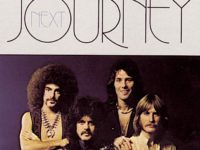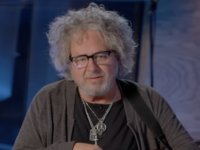Former Journey drummer Steve Smith joins his old bandmate Neal Schon as part of this week’s all-star tribute concert honoring Ronnie Montrose on Friday, April 27, 2012, on a bill that also includes the remaining members of the band Montrose and stars from Styx, Kiss and Chickenfoot.
“We are all looking forward to playing together for Ronnie’s memory and helping out his wife Leighsa,” Smith tells us.
Smith was part of Montrose’s band in 1978, as the late legendary guitarist toured behind the solo release Open Fire. That gave Smith an opportunity to share the stage with the newly emerging Van Halen as well as Journey, the group with whom Smith would eventually soar to multi-platinum, stadium-filling superstardom into the 1980s.
Montrose died at age 64 on March 3, having taken his own life after a five-year battle with prostate cancer. An ace sessions man, the guitarist rose to fame fronting an eponymous band featuring a then-unknown Sammy Hagar. Friday, Hagar will join fellow original Montrose cohorts Denny Carmassi and Bill Church — along with special guest Joe Satriani, guitarist in Hagar’s current group Chickenfoot. Also scheduled to perform are sidemen from Montrose’s subsequent band Gamma, Ricky Phillips of Styx, Eric Singer of Kiss, Eric Martin of Mr. Big, Jimmy Degrasso of Y&T and members of Tesla. Denny Carmassi will perform with both Montrose and Gamma; Marc Bonilla will also be featured with Gamma.
Smith, in the latest SER Sitdown, talks about Montrose’s seminal role in helping the drummer make the transition from jazz bands to rock, how Smith came to meet his future employers in Journey, and how Montrose measured up on that memorable late 1970s tour that featured both Neal Schon and Eddie Van Halen …
NICK DERISO: Ronnie Montrose’s passing must have stirred up a lot of memories from your time in his band. How did you come to play with the guitar legend?
STEVE SMITH: After I toured and recorded with Jean-Luc Ponty from late ’76 and all of 1977, I moved from Boston to Los Angeles in January of ’78 to get into the music business. During the first week I was in LA, I was able to line up two auditions — one was for Freddie Hubbard, the great jazz trumpet player, and the other was for Ronnie Montrose in San Francisco. I did the auditions, and got both gigs, so I had to make a choice of which direction to follow. I felt that I had already played a lot of jazz and, even though playing with Freddie Hubbard would have been an awesome experience, I decided to tour with Ronnie Montrose. I had never worked with any professional rock musicians at that point and I liked the music and direction of Open Fire, which was the album Ronnie had just released and we would be playing that music live.
[ONE TRACK MIND: Steve Smith goes in-depth on songs from throughout his career, offering insights into recordings with Journey, Jean-Luc Ponty and his long-standing jazz group Vital Information.]
NICK DERISO: Talk about a crossroads moment. Jazz and Freddie Hubbard in one direction, rock and Ronnie Montrose in the other.
STEVE SMITH: The way I saw it, my career was an adventure and I had options, playing with Ronnie felt like a very interesting option. When I played with Jean-Luc, he had asked me to change from playing a small jazz kit to playing a double bass drum “Billy Cobham” kit; that was the way Ponty described it. I was enjoying playing the large kit and playing in a very aggressive high-energy fusion direction. If I took the gig with Ronnie, I could continue in that direction. If I toured with Freddie, I would have gone back to the jazz kit and playing in clubs with acoustic pianos and acoustic bass, so the volume would have been much lower — which is closer to how I’m playing now! (Laughs.) But for a 23-year-old kid, I wanted to see what rock ‘n’ roll was about. That seemed like a very interesting option, indeed!
NICK DERISO: Montrose’s fusion-based sound must have helped ease the way, in some respects.
STEVE SMITH: The gig with Ronnie wasn’t a straight rock gig. It was instrumental rock in a similar direction to Jeff Beck: Instrumental, virtuosic rock. It was the perfect gig for me, and the way I see it in retrospect, the perfect bridge that prepared me for the type of drumming that I developed playing with Journey. Ronnie told me to “go nuts,” meaning play my ass off and really fill up the space in the music. He wanted me to play like Billy Cobham, Narada Michael Walden or Simon Phillips, drummers that were playing with Jeff Beck, John McLaughlin or Stanley Clarke. I could do that — and if you see the videos of Ronnie in ’78 that have recently been put on wolfgangsvault.com you can see that’s exactly what I did!
NICK DERISO: What did you learn from those early experiences?
STEVE SMITH: Ronnie’s sound was huge and his time was settled and consistent. I thought he played melodies with a lot of soul and feeling. I really learned a lot from Ronnie about constructing a strong set and presenting instrumental music in a way that communicated to a large audience. We had a ball playing together. In some songs, we played guitar and drum duets that stretched on and on. Off-stage, he was fun and relaxed — but he was also a serious guy who was into psychology and philosophy.
NICK DERISO: Do you have a favorite memory, something that you’ve carried with you over the years from that time with Montrose?
STEVE SMITH: I have great memories of playing with Ronnie: I played with him from January to September ’78 and I left his group to become a band member of Journey. The first three months that I played with Ronnie, we were on a package tour of the USA that was Journey’s first headline tour, they had just released Infinity. The opening act was Van Halen, it their very first time on tour ever. The middle act was Ronnie Montrose with me on drums. It’s interesting to look at the elements that were present on that tour. I think Ronnie was under pressure to perform because the show featured some pretty amazing guitar playing. Eddie Van Halen had just arrived on the scene and he was blowing everyone away with his virtuosity and new ideas on how to play the guitar. Neal Schon similarly came on the scene in the early ’70s when both Clapton and Santana asked him to join their bands — and Neal went with Santana at 16 years old. I think he blew people’s minds in those days. Ronnie had also come on the scene with Edgar Winter in the early ’70s and had blown some minds, too! His group Montrose was the template from which Van Halen was born, complete with a band named after the guitar player, their first album produced by Ted Templeman — and eventually the singer from Montrose became the singer for Van Halen! There was a lot of “guitar hero” energy on that tour and Ronnie wanted to get on stage and kick ass. We followed Van Halen, and we wanted to make it hard for Journey to follow us. There was friendly, but fierce, competition on that tour, with each group was trying to out play the other.
[SOMETHING ELSE! INTERVIEW: Steve Smith talks about reuniting with Neal Schon for a new 2012 project — and just how underrated the initial fusion-inspired edition of Journey still is.]
NICK DERISO: Within a few months, you had jumped ship to Journey, where you remained for some 10 years between 1978–85 and 1995–98. How did that happen?
STEVE SMITH: During that tour, all the musicians hung out together and I got to know the guys in Journey, which eventually led to them asking me to join the band. Ronnie was supportive of that and knew that it was a good move for me. He could see that Journey had a strong future and that I was interested in taking the next step on my musical adventure, which was playing with a rock group that had vocals. Funny as that sounds, I had never worked with a proper singer until Journey. I had been playing only instrumental music and when I played “Holiday Inn”-type commercial gigs when I was in high school and college one of the musicians would sing and they were usually not very good. I left Ronnie’s group with his blessing. In fact, Ronnie and I worked together a few years later when he produced Jeff Berlin’s first album. That is a fantastic jazz-fusion record called Champion that also features Scott Henderson, T Lavitz, Neal Schon and Neil Peart on a couple of tunes. There is one song that has Neil and I both playing drums together (“Subway Music”). Ronnie did a wonderful job of grounding Jeff’s music with excellent sound and polished performances.
[amazon_enhanced asin=”B001TXQEC0″ container=”” container_class=”” price=”All” background_color=”FFFFFF” link_color=”000000″ text_color=”0000FF” /] [amazon_enhanced asin=”B007TKBDIW” container=”” container_class=”” price=”All” background_color=”FFFFFF” link_color=”000000″ text_color=”0000FF” /] [amazon_enhanced asin=”B0002GFK6Q” container=”” container_class=”” price=”All” background_color=”FFFFFF” link_color=”000000″ text_color=”0000FF” /] [amazon_enhanced asin=”B0054YH57S” container=”” container_class=”” price=”All” background_color=”FFFFFF” link_color=”000000″ text_color=”0000FF” /] [amazon_enhanced asin=”B000O6IR6Y” container=”” container_class=”” price=”All” background_color=”FFFFFF” link_color=”000000″ text_color=”0000FF” /]
Friday’s event, called “A Concert for Ronnie Montrose: A Celebration Of His Life In Music,” will take place at the Regency Ballroom in San Francisco, California. For more, go to TheRegencyBallroom.com.
- How Deep Cuts on ‘Music From Big Pink’ Underscore the Band’s Triumph - July 31, 2023
- How ‘Islands’ Signaled the Sad End of the Band’s Five-Man Edition - March 15, 2022
- The Band’s ‘Christmas Must Be Tonight’ Remains an Unjustly Overlooked Holiday Classic - December 25, 2016




